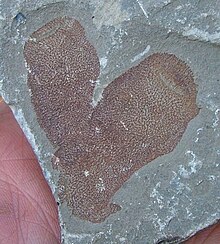Hazelia
| Hazelia Temporal range:
| |
|---|---|

| |
| A specimen of Hazelia at the Mount Stephen Trilobite Beds | |
| Scientific classification | |
| Kingdom: | Animalia |
| Phylum: | Porifera |
| Class: | Demospongiae |
| Order: | †Protomonaxonida |
| Family: | †Hazeliidae |
| Genus: | †Hazelia Walcott, 1920 |
| Species | |
Hazelia is a genus of spicular Cambrian demosponge known from the Burgess Shale, the Marjum formation of Utah,[4] and possibly Chengjiang.[1] It was described by Charles Walcott in 1920.[5]
Its tracts are mainly radial and anastomose to form an irregular skeleton.[4] Its oxeas form a fine net in the skin of the sponge.[4]
References[]
- ^ a b Botting, J. (2007). "'Cambrian' demosponges in the Ordovician of Morocco: Insights into the early evolutionary history of sponges". Geobios. 40 (6): 737–748. doi:10.1016/j.geobios.2007.02.006.
- ^ Rigby, J. K. (1986). "Sponges of the Burgess shale (Middle Cambrian), British Columbia". Palaeontographica Canadiana (2).
- ^ a b Rigby, J. K.; Collins, D. (2004). "Sponges of the Middle Cambrian Burgess Shale and Stephen Formations, British Columbia". ROM contributions in science. 1. ISBN 0-88854-443-X. ISSN 1710-7768.
- ^ a b c J. Keith Rigby; Lloyd F. Gunther; Freida Gunther (1997). "The First Occurrence of the Burgess Shale Demosponge Hazelia palmata Walcott, 1920, in the Cambrian of Utah". Journal of Paleontology. 71 (6): 994–997. JSTOR 1306598.
- ^ Walcott, C. D. (1920). "Cambrian geology and paleontology IV:6—Middle Cambrian Spongiae". Smithsonian Miscellaneous Collections. 67: 261–364.
External links[]
- "Hazelia palmata". Burgess Shale Fossil Gallery. Virtual Museum of Canada. 2011.
Categories:
- Protomonaxonida
- Burgess Shale sponges
- Maotianshan shales fossils
- Cambrian first appearances
- Middle Ordovician extinctions
- Prehistoric sponge genera
- Taxa named by Charles Doolittle Walcott
- Fossil taxa described in 1920
- Cambrian animal stubs
- Ordovician animal stubs
- Prehistoric sponge stubs
- Demospongiae stubs